
Mercury Cooker Hoods: PC1000/1082/1100/1200
Revision: 22/11/2012
2
ENGLISH
SECTION 1. INTRODUCTION
Your range cooker is a semi-professional unit which gives you the power and flexibility to realise your full
potential in the kitchen. Inevitably, during the cooking process, there will be heat, vapours and fumes
produced. Your Falcon extractor has been designed to complement the range cooker both in looks and
performance in order to create the ideal environment for creative cooking.
SECTION 2. EXTRACTION PERFORMANCE
The most important influence on the performance of the extractor is the design of the ducting which
takes the exhaust air from the extractor to the outside wall louvre. The duct route should be a prime
consideration during the initial stages of the kitchen design. Please note the following:
•
The extractor is provided with a spigot suitable for connecting 150mm diameter duct.
•
Note: 150mm is the minimum duct diameter consistent with efficient extraction.
•
The exhaust duct route length should be kept as short as possible with as few bends as possible.
•
The most efficient configuration is to duct straight through an outside wall so try to position the
cooker against an outside wall when designing your kitchen layout.
•
The hood can be vented either to the top exhaust or the rear exhaust position. Use the position
which gives the shortest duct route length and least number of bends. (The blower will need to be
rotated for ducting directly through the rear exhaust position.)
•
A route with more than two 90 bends will significantly degrade the performance of the extraction
system. If possible, avoid having a 90 bend at the extractor exhaust spigot; keep bend radii as
large as possible to maintain a smooth airflow without vortices; avoid kinks in flexible ducting; pull
flexible ducting taut over straight runs to ensure that the internal surface is as smooth as possible.
SECTION 3. IMPORTANT INFORMATION
The following minimum headroom is required to accommodate the cooker and hood:
For a small charge customised replacement chimneys can be produced to suit your requirements.
The minimum distance between the range hob burners and the bottom of the extractor is essential to
prevent overheating of the extractor and its components.
If you are fitting a splashback then the cooker-to-hood clearance is dictated by the splashback height.
Please also note that a 90 bend in the flexible ducting will require 215mm minimum headroom to give a
smooth radius with no kinking.
Requirements of the relevant authorities concerning the discharge of exhaust air must be complied with.
Attention:
This appliance requires an earth connection.
Ensure that the supply voltage corresponds to that marked on the rating label inside the extractor.
The extractor must be isolated from the electrical supply before carrying out any cleaning or mainte-
nance operations.
Pay particular attention to fire risk when frying. To minimise the risk of fire, all instructions
relating to cleaning the grease filters and removing grease deposits must be adhered to.
Do not flambé under the extractor.
SECTION 4. INSTALLATION
4.1 Removing the Grease Filter(s)
Place extractor on its backplate on a horizontal surface.
To remove the grease filters pull/lift the filter release lever away from the hood base. This releases the
retaining clips allowing the filter to be carefully lifted away from the hood. Take care not to scratch the
hood.
The internal fixing holes, blower assembly and spigot blanking plate can now be accessed through the
openings in the baseplate. (See Page 7).
4.2 Blower Exhaust Position
The hood can be vented either to the top exhaust or the rear exhaust position. Each exhaust position
has 4 studs onto which can be bolted either the blower assembly or a blanking plate.
Bolt blower assembly to chosen exhaust position and the blanking plate to the unused position.
When changing the exhaust position, care should be taken not to excessively pull or twist the cable
attached to the blower.
4.3 Duct Installation
Make a hole in the wall or ceiling to take the 150mm diameter ducting from the extractor exhaust spigot
to the outside.
The exhaust duct route length should be kept as short as possible with as few bends as possible - see
Section 2.
Knock a hole in the outside wall to match the internal measurements of the louvre.
4.4 Fixing the Hood to the Wall
If you are fitting a Splashback it must be fitted before the hood.
Instructions for mounting the hood are given on page 7
Note: The decorative chimney can be removed to ease handling of the hood.
The supporting wall must be of good quality, have an even surface and be sturdy enough to support the
extractor.
Fixings must be used which are suitable for the type of wall construction.
4.5 Connecting the Ducting
Connect ducting to extractor exhaust spigot. This may have to be done prior to fixing the extractor to the
wall. You may find this easier with the chimney removed. The chimney is attached using M4 machine
screws which can be accessed through the filter opening(s).
When the extractor is in position, check that the duct has not been flattened or kinked along its route.
Connect the ducting to the wall louvre spigot or alternative outside termination.
Secure the louvre to the outside wall. Ensure that any air fins are directed downwards.
Refit the grease filter(s).
4.6 Electrical Installation
The extractor is a stationary appliance designed to be connected by fixed wiring to the electrical supply.
A competent electrical technician must perform the electrical installation.
The extractor must be fed from a 230Vac single phase electrical supply using a switched spur fitted with
a 3A fuse. The spur should be located adjacent to the extractor/cooker so that the supply can be discon-
nected from the extractor using the switch. The means of disconnecting from the supply must have a
minimum contact separation of 3mm in all poles. Alternatively a means of disconnection in the fixed
wiring according to the relevant wiring rules must be fitted.
A supply cord for connecting the spur to the extractor is included.
The mains supply is connected to the free end of this cord as follows:
SECTION 5. OPERATING INSTRUCTIONS
a. Switch power on at the fused spur.
b. The extractor has 6 push-buttons which illuminate when selected. Their functions are summarised
in the table below.
c. The extractor controller will automatically switch off the appliance if there has been no operator
action for 4 hours.
d. After 30 hours accumulated running GREASE FILTER SATURATION will be signalled by all 6
indicators flashing. Reset by pressing Push-button FAN OFF (delay).
SECTION 6. MAINTENANCE
Regular maintenance is essential to ensure good performance and long-life.
To clean the stainless steel surfaces of the extractor use a proprietary cleaning agent. Do not use
abrasive cleaning materials or products.
Clean the grease filters in a dishwasher or by hand-washing in hot water and detergent. Wash the filters
at least every 2 months - sooner if the extractor is used extensively.
To remove the grease filters pull the chrome effect filter release lever away from the hood base. This
releases the retaining clips allowing the filter to be carefully lifted away from the hood. Care should be
taken not to scratch the hood.
To maintain the immaculate appearance of the extractor, and to minimise fire risk, ensure that grease
deposits on the extractor surfaces are kept to a minimum by regular cleaning.
To access the halogen lamps for replacement lever off the chrome ring immediately surrounding the
matt glass with a screwdriver. Only replace with bulbs of the same type and rating.
SECTION 7. SPECIFICATIONS
Hood Weights (Approximate)
Cooker-to-hood clearance (min): 800 mm
Hood height including chimney: 511—762 mm
Minimum ceiling height with standard chimney: 2251mm
Warning
Proper care must be taken to ensure that the negative pressures caused by high performance
extraction systems do not adversely affect the safe operation of certain types of fuel-burning
appliances (gas, oil or solid fuel), including those installed in the kitchen and possibly also those
installed in other parts of the house.
Where such fuel-burning appliances are installed, adequate ventilation MUST be provided in the
room of installation, located and sized such that the negative pressure in the room created by the
extractor does not exceed 4Pa.
In case of doubt, do not operate the extractor and fuel-burning appliance(s) simultaneously and
consult an appropriate (for the fuel type) expert for advice.
The exhaust air must not be discharged into a flue which is used for exhausting fumes from appli-
ances supplied with energy other than electricity, e.g. oil or gas-fired central heating boilers, gas-
fired water heaters, etc.
Adequate ventilation of the room must be provided when the cooker, extractor and appliances
supplied with energy other than electricity (e.g. gas-fired or oil-fired heaters, etc.) are used simulta-
neously. The room must be provided with vents to allow a constant flow of fresh air.
ELECTRICAL HAZARD
DISCONNECT ELECTRICAL SUPPLY
BEFORE PROCEEDING FURTHER
INCOMING SUPPLY CORD CONNECTIONS
Core
Core Colour
Live Brown
Neutral Blue
Protective Earth Green/Yellow
Blower airflow, nominal:
1000 m
3
/hr
Noise level:
52dBA
Supply voltage:
230V~ 50Hz
Halogen lamp voltage:
12V
Blower power input:
1 @ 250W
Halogen lamp power:
2 x 20W
Total power:
290W
Fuse size for electrical supply:
3A
Blower spigot diameter:
150mm
PC1000
28Kg
PC1082/1100
29Kg
PC1200
29.5Kg
Pushbutton Function
LIGHTS ON/OFF
0 1
FAN ON SPEED 1 (min);
FAN OFF (immediate stop).
2 FAN ON SPEED 2
3 FAN ON SPEED 3
4 FAN ON SPEED 4 (max)
FAN OFF AFTER 10 MINUTE DELAY to clear residual fumes;
indicator flashes during time-out.

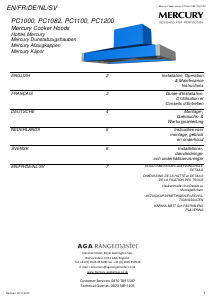


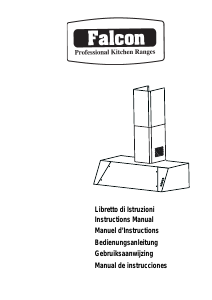
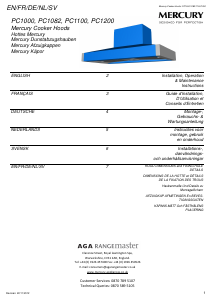
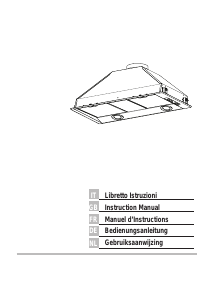
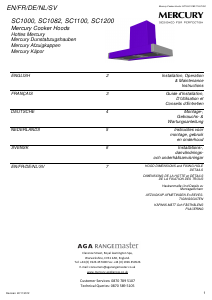
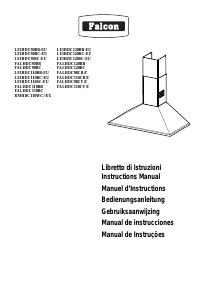
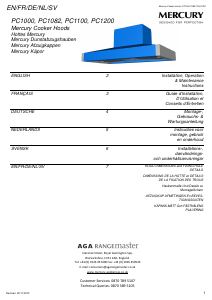
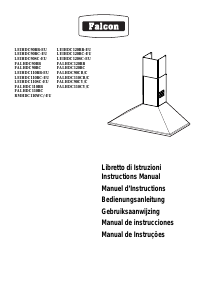

Joignez-vous à la conversation sur ce produit
Ici, vous pouvez partager ce que vous pensez du Falcon PC 1200 Hotte aspirante. Si vous avez une question, lisez d’abord attentivement le mode d’emploi. La demande d’un mode d’emploi peut être effectuée en utilisant notre formulaire de contact.